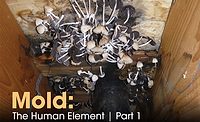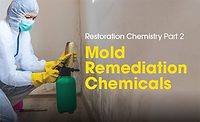Mold Remediation: The Human Element | Part 2
Handling specialty cases and third parties during mold remediation.

Common wall damage between two units. Photos courtesy of ASR
In the first article of this two-part series, we talked about difficult scenarios that arise when we are handling claims involving property owners, tenants, and others with shared responsibility in multi-family losses. In part two, we will take a closer look at the human element of handling specialty mold remediation cases.
The Mold-Sensitized Individual
Sometimes in addition to an owner or tenant creating the difficulties mentioned in part one of this series, there are other elements involved of which remediators should be aware. The first is what is commonly referred to as sensitized individuals. These individuals are much more sensitive to mold exposure and their needs should never be taken lightly. Their symptoms and illness are typically due to either genetics or a heightened allergic response, and therefore these customers can be extremely sensitive to not just bio-aerosols like mold and bacteria, but even simple odors such as the deodorant or cologne you may be wearing.
Did you miss Part I of Mold Remediation: The Human Element? No problem! Click here!
Each step in your remediation plan must be carefully reviewed and communicated to the individual in order to help prevent a situation that could affect them. Your contract and documentation must be stellar. They will likely need to see the SDS for all the products you will be using and sign off on them. Equipment (and you) will need to be cleaned before coming into the home. They need to know that if they choose to live in the home during the remediation (which I highly advise against), there will be areas contained and under negative air. They need to know where that negative air is exhausting to and that the possibility exists they will not be able to use their HVAC system. Placement of your decontamination chambers and your egress throughout the home must be carefully planned and communicated. Furthermore, you need to remember that even after you finish your remediation and are successful with your post-remediation verification, these sensitivities will never go away for them. You will need to assure that the source of the problem has been resolved and possibly inspect for other areas of concern.

Crawlspace mold from a very long term loss. Photos courtesy of ASR
The “Educated” Client
There is another type of customer that we have all ran into: the customer who knows more than you despite your years of experience and education. They are typically scientists, doctors, or even just an individual who has been through the trials of mold remediation in the past. In California, we consistently encounter the ones that are the most fun… lawyers. It could also be a fungi-phobic individual who spends his/her entire day researching mold on the all-wise internet. Either way, these individuals can make jobs quite challenging.
The best way to prepare for these situations is to maximize your education. In most cases, these people possess knowledge comparable to a technician level of education. This gives them plenty of information. I’m sure many of you have heard a client tell you “I think that is Stachybotrus”, yet they don’t know how to pronounce it. They also don’t know that it typically takes seven to 10 days to grow. You might find even with all of their “advanced knowledge” regarding mold, they have several humidifiers running in the house and the RH is off the charts.
As ridiculous as some of their claims may sound, you should still respect their commitment to educating themselves. They will be watching your every move. You will also encounter the individuals who are so educated they attempt to begin remediation themselves by donning a dust mask, spraying some bleach, and throwing out a few pieces of impacted drywall. When they discovered the mold impacted the framing and is a bigger job than they want to take on, they called you. They didn’t realize the home being built in 1965 was a concern. Now you have a situation where the rest of the dwelling is potentially contaminated with not just mold, but asbestos and lead as well. If you take this project on, you will be responsible for ensuring all areas of the home are brought back to a healthy living environment. Most importantly, you must find a way to do all of this without insulting the individual’s intelligence, perceived or otherwise.

Unreported growth in a garage closet caused by an HOA responsibility. Photos courtesy of ASR
The Hoarder
Perhaps the one individual that takes the wind out of our sails the most when we walk through the door is the hoarder. You walk up to the home expecting to assess damage from what you have been told is a possible slab leak. The door opens (sometimes partially), and you discover a hoarding situation which prevents you from inspecting anything.
We all immediately start to do the math in our head of what will be needed to perform the content manipulation, cleaning and potential remediation. We dread the physical obstacles we know are involved.
The most important element to these projects though, is the human one. Hoarders are the opposite of the educated or sensitized individuals. The latter wants the problem fixed quickly and properly, sometimes to the extreme. The hoarder however, does not want to be disturbed at all. Sometimes, they won’t even let you in the door even though a property manager has hired you to take care of the problem.
Hoarding is a mental illness. Several hoarders I have met are not aware of the concerns or safety hazards in the home. They feel the number of belongings they have is normal. Again, this is a mental condition and you can’t blame them for it, but you do have to find a way to work with them. More times than most, my approach is to immediately try and get a family member involved to help with access, decision making, and relocation.

Often, hoarders do not want anything thrown away. In the event they do, you must have documentation of this authorization that releases you from any responsibility of damage to any contents in the dwelling. Once you begin the work, you will probably find other areas damaged by mold and/or bacterial impact. It is not uncommon to find neglected previous damage, expired food products, or even rat droppings. This is definitely an instance where living conditions will affect a loss. A slab leak which is usually considered a Category 1 loss is immediately considered a Category 3 due to the contaminants in the water. Even if the original damage is located in one room, the entire home is probably contaminated either by air distribution through the HVAC, or just the living condition itself. You could have a mixture of all three mold conditions throughout the home. As the mold professional, you are responsible for the health and safety of yourself, your workers, and any other occupants. You can’t just remediate one area then ignore the rest. Once the contents have been removed, the first step should be to have sampling done in all areas of the home. Many of us do our own sampling, but in a situation like this I would certainly have a third party involved. I would have them perform air sampling in each room at a minimum. I would also request that a scope of work is written up front and agreed upon by all parties. You can see how a simple slab leak where you would normally pull some carpet pad and set drying equipment has now turned into a large remediation project with several days of content manipulation and restoration, all due to the human element involved.
Third Parties
Sorry everyone. As much as we all love them, I am not talking about TPA’s. The third parties I am referring to are property managers, real estate agents, plumbers, basically anyone involved with the property with their own agenda and needs. These additional stakeholders all have jobs to do and the condition of the home affects each one in a unique way. In some instances, you could be hired directly by the property manager and not by the homeowner. Many times, the manager has a different view than the homeowner as to how the job should be done or who is responsible. We run into this situation constantly in the HOA market. Here is an example of how complex these situations can be:
The PROPERTY MANAGER calls us because they had a leak in the bathroom ceiling that was just reported to them by their resident on the first floor. This is a TENANT who noticed it six months ago but it is now getting worse and they are concerned. They want to be sure there isn’t any mold because they have a newborn baby. The property manager had their PLUMBER go out to take a look, but they refuse to open anything up as they are concerned with mold as well and don’t want to be responsible for an exposure. You go out to perform your initial inspection and find that not only is the ceiling affected with obvious staining, but your moisture survey finds that water has migrated down the exterior insulated wall, behind a vanity and under some laminate flooring. The property manager discusses your findings with the HOMEOWNER and authorizes you to proceed. As you begin remediation of the wet materials, you not only find substantial microbial growth, but you also see that the subfloor above is heavily saturated. Upon inspection of the unit above, you find that the drain line in the wall that ties into each bathroom in the stack has a crack in it that has been slowly leaking, which ends up being the responsibility of the HOA. The HOA files a claim with their INSURANCE. That adjuster states that the HOA is responsible for the walls and subfloor, but the individual owners are responsible for flooring, cabinetry, paint, etc. The owner above files a claim with their INSURANCE. The unit below files a claim with their INSURANCE.

You will notice that I capitalized each individual stakeholder involved in this project, which totals seven. It could very quickly grow from there if the property is for sale and there are real estate agents involved. Each stakeholder has justifiable needs that require your expert professional attention. The property manager needs the job handled quickly and trusts you to prevent complaints or problems from coming up. The plumber has a job to do and a schedule to keep. The three separate insurance adjusters need updates and documentation. The tenants would love to have their bathroom operational again and are very worried about exposure to their newborn. As the mold professional, you need to ensure you meet the needs of everyone involved while protecting yourself from any ramifications that could evolve from any, or all of the seven. Through all of this you should be keeping in mind that most of these stakeholders can be potential sources of future work for you as well.
Maintaining Best Practices
When it comes to a remediation project, the work is the easy part. You can build the best containments in the world. We must always remember this is new to the client, even if it’s just another day at work for us. Based on the dynamic or mental state of the person involved, this can be more catastrophic to some than others. Unfortunately, there are restoration contractors out there who view these people as difficult and end up turning down work. Focusing on how to navigate the challenges of different human elements involved in each job you do will help set you apart from the rest. Our ability to communicate and hold their hand through the process is the measure of success that they will always remember.
Looking for a reprint of this article?
From high-res PDFs to custom plaques, order your copy today!






